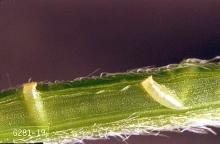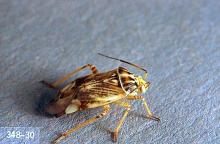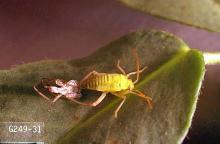Lygus spp., especially tarnished plant bug (Lygus lineolaris)
Pest description and crop damage Adult tarnished plant bugs are about 5-6 mm in length and their color is variable: they may be pale green to dark brown with yellow, black, and occasionally red markings. Their feeding on buds, bloom, and small fruit results in deformed berries. Lygus is generally not a problem pest except, possibly, later in the summer on day-neutral strawberries.
Biology and life history The lygus bug overwinters as an adult in groundcover. As temperatures increase above 46ºF, they emerge from cover to feed. They have a wide host range that includes many weeds, tree fruits, and berries. They will move from host plant to host plant as the year progresses; as these plants finish flowering or dry up, lygus bugs will seek other host plants. There are about three generations per year.
Scouting and thresholds These insects are difficult to monitor as they are found on a wide range of hosts and fly away quickly if disturbed. Sweep nets may be used to monitor for the presence of the insects, though no thresholds exist.
Management-chemical control: HOME USE
- azadiractin-Some formulations are OMRI-listed for organic use.
- bifenthrin
- carbaryl
- horticultural oils
- malathion
- permethrin
- plant essential oils (clove, garlic, peppermint, rosemary)-Some formulations are OMRI-listed for organic use.
- pyrethrins-Some formulations are OMRI-listed for organic use.
Management-chemical control: COMMERCIAL USE
- acetamiprid (Assail and others) at 0.075 to 0.13 lb ai/A. PHI 1 day. Hazardous to bees.
- azadiractin (Ecozin and others)-Consult label for rate. PHI 0 days. Some formulations are OMRI-listed for organic use.
- Beauveria bassiana (Mycotrol and other brands)-Consult label for rate. Some formulations are OMRI-listed for organic use.
- bifenthrin (Brigade and other brands) at 0.04 to 0.2 lb ai/A. PHI 0 days. Do not apply more than 0.5 lb ai/A per season. Toxic to bees. Restricted use pesticide.
- Chromobacterium subtsugae (Grandevo)-Consult label for rate. PHI 0 days. Temporarily repels bees; adjust use accordingly. OMRI-listed for organic use.
- fenpropathrin (Danitol) at 0.2 lb ai/A. PHI 2 days. Do not exceed two applications. Restricted use pesticide.
- flonicamid (Beleaf 50 SG) at 0.089 lb ai/A. PHI 0 days. Apply when lygus bugs first appear.
- malathion-Consult label for rates. PHI 3 days. Hazardous to bees.
- naled (Dibrom) at 0.94 lb ai/A. PHI 1 day. Use in evening after bee activity has ended. Restricted use pesticide.
- pyrethrins (PyGanic) at 0.01 to 0.05 lb ai/A. PHI 0 days. Hazardous to bees. Some formulations OMRI-listed for organic use.
- sodium borate (Prev-Am)-Consult label for rate. PHI 1 day.
- tolfenpyrad (Bexar) at 0.28 lb ai/A. PHI 1 day. Hazardous to bees.



